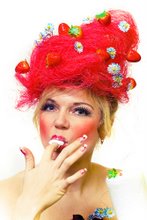
In a fit of mommy-guilt, I once spent twelve hours constructing an edible tableaux of the pyramids at Giza for my son's fifth birthday--layer upon layer of homemade yellow cake and chocolate butter cream. It was a masterpiece, complete with brown sugar sand, plastic palm trees and camels. Even better, it tasted divine.
He, of course, hated it.
Okay, that's not really fair. He actually remembers it rather fondly. But at the time, we both knew he would have been much happier digging into a store-bought cake with fluorescent green frosting an a plastic Mutant Turtle on top.
I had felt the need to save his little untrained palate from certain disappointment. I had failed.
Such is the fate of parenthood. Homemade cakes give way to semi-homemade cakes, which give way to store-bought monstrosities so laden with shortening and sugar that the actual cake seems an afterthought. Maybe it's just hiding in shame.
But there is salvation to be found, and it's name is tres leches. Well-known to the fiesta-set, this creamy, dreamy, milk-laden cake is a homemade(ish) antidote to industrialized desserts.
The recipe goes like this--a pan of sponge cake gets jabbed and poked within an inch of its life, then doused with a mixture of evaporated and condensed milk, along with heavy cream (three milks=tres leches). Let soak, then cloak the whole thing in a n inch of whipped cream. Purists prefer their cake unadorned, though I think adding a layer of fruit makes for a better party.
The cakes ends up a bit like a thoroughly soused rum cake, minus the rum: Sweet, spongy and insanely moist--sometimes almost wet. The whipped cream frosting is rich, but goes down a lot better than heavy buttercream or (shudder) shortening-based frosting. !Ole!
No one's quite sure where this confectionery marvel got its start, although popular belief places its origins in Central America. More specifically, it's thought to have come from a recipe on the side of a sweetened or condensed milk can somewhere in Nicaragua--not such a wild theory due in part to the prevalence of canned milk in hot climates (where the fresh stuff doesn't last long).
The recipe remains popular in Latin American countries and, like flan and dulce de leche, has kindly infiltrated US food culture. You'll find it everywhere from local Mexican bakeries to the dessert menus of upscale restaurants (Cindy's Backstreet Kitchen in St. Helena frequently has it on the menu.)
Don't expect to walk up and get a slice, however. Cakes usually need to be ordered in advance from local Mexican bakeries (as BiteClub found out the hard way), but high-traffic spots like Lola's Market and (BiteClub's fave) Pasteles Fiesta usually have a selection on hand for walk-ins. Pasteles also has slices available with or without fruit for dabblers and lunch-breakers.
And yes, you can even get them decorated with green frosting, pink flowers and nifty toys. Making everyone happy.
If you go: Pasteles Fiesta offers a variety of authentic Mexican cakes, along with tasty individual-sized flans. A small tres leches cake will set you back about $20; the mini flans are just $2. 443 Dutton Ave, #1, Dutton Plaza, Santa Rosa, 707.568.7051.
If you want to make Tres Leches cake yourself (you ambitious cook, you) can check out the recipe that got me all inspired in the first place, courtesy of Alton Brown and the Food


1 comment:
Hello. This post is likeable, and your blog is very interesting, congratulations :-). I will add in my blogroll =). If possible gives a last there on my blog, it is about the TV Digital, I hope you enjoy. The address is http://tv-digital-brasil.blogspot.com. A hug.
Post a Comment